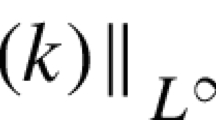Abstract
The classical Rayleigh–Taylor instability occurs when two inviscid fluids, with a sharp interface separating them, lie in two horizontal layers with the heavier fluid above the lighter one. A small sinusoidal disturbance on the interface grows rapidly in time in this unstable situation, as the heavier upper fluid begins to move downwards through the lighter lower fluid. This paper presents a novel numerical method for computing the growth of the interface. The technique is based on a spectral representation of the solution. The results are accurate right up to the time when a curvature singularity forms at the interface and the inviscid model loses its validity. A spectral method is then presented to study the same instability in a viscous Boussinesq fluid. The results are shown to agree closely with the inviscid calculations for small to moderate times. However, the high interface curvatures that develop in the inviscid model are prevented from occurring in viscous fluid by the growth of regions of high vorticity at precisely these singular points. This leads to over-turning of the interface, to form mushroom-shaped profiles. It is shown that different initial interface configurations can lead to very different geometrical outcomes, as a result of the flow instability. These can include situations when detached bubbles form in the fluid.
Similar content being viewed by others
References
Lord Rayleigh (1883) Investigation of the character of the equilibrium of an incompressible heavy fluid of variable density. Proc Lond Math Soc 14: 170–177
Sir Taylor GI (1950) The instability of liquid surfaces when accelerated in a direction perpendicular to their planes, I. Proc R Soc Lond A 201: 192–196
Sharp DH (1984) An overview of Rayleigh-Taylor instability. Physica D 12: 3–18
Kull HJ (1991) Theory of the Rayleigh-Taylor instability. Phys Lett 206: 197–325
Inogamov NA (1999) The role of Rayleigh-Taylor and Richtmyer-Meshkov instabilities in astrophysics: an introduction. Astrophys Space Phys 10: 1–335
Lazier J, Pickart R, Rhines P (2001) Deep convection. In: Siedler G, Church J, Gould J (eds) Ocean circulation and climate: observing and modelling the global ocean, vol 77 in international geophysics series. Academic Press, San Diego, pp 387–400
McClure-Griffiths NM, Dickey JM, Gaensler BM, Green AJ (2003) Loops, drips, and walls in the galactic chimney GSH 277+00+36. Astrophys J 594: 833–843
Moore DW (1979) The spontaneous appearance of a singularity in the shape of an evolving vortex sheet. Proc R Soc. Lond A 365: 105–119
Cowley SJ, Baker GR, Tanveer S (1999) On the formation of Moore curvature singularities in vortex sheets. J Fluid Mech 378: 233–267
Krasny R (1986) Desingularization of periodic vortex sheet roll-up. J Comput Phys 65: 292–313
Baker GR, Pham LD (2006) A comparison of blob-methods for vortex sheet roll-up. J Fluid Mech 547: 297–316
Tryggvason G, Dahm WJA, Sbeih K (1991) Fine structure of vortex sheet rollup by viscous and inviscid simulation. J Fluids Eng 113: 31–36
Tryggvason G, Unverdi SO (1990) Computations of three-dimensional Rayleigh-Taylor instability. Phys Fluids A 2: 656–659
Stone JM, Gardiner T (2007) Nonlinear evolution of the magnetohydrodynamic Rayleigh-Taylor instability. Phys Fluids 19: 094104:19
Forbes LK, Chen MJ, Trenham CE (2007) Computing unstable periodic waves at the interface of two inviscid fluids in uniform vertical flow. J Comput Phys 221: 269–287
Forbes LK, Hocking GC (2007) Unsteady draining flows from a rectangular tank. Phys Fluids 19: 082104:14
Farrow DE, Hocking GC (2006) A numerical model for withdrawal from a two-layer fluid. J Fluid Mech 549: 141–157
Batchelor GK (1967) An introduction to fluid dynamics. Cambridge University Press, Cambridge
Atkinson KA (1978) An introduction to numerical analysis. Wiley, New York
Baker G, Caflisch RE, Siegel M (1993) Singularity formation during Rayleigh-Taylor instability. J Fluid Mech 252: 51–78
Gradshteyn IS, Ryzhik IM (2000) Tables of integrals, series and products, 6th edn. Academic Press, San Diego
Tryggvason G (1988) Numerical simulations of the Rayleigh-Taylor instability. J Comput Phys 75: 253–282
Kreyszig E (2006) Advanced engineering mathematics, 9th edn. Wiley, New York
von Winckel G, lgwt.m, at: MATLAB file exchange website, written (2004) http://www.mathworks.com/matlabcentral/fileexchange/loadFile.do?objectId=4540&objectType=file
Author information
Authors and Affiliations
Corresponding author
Rights and permissions
About this article
Cite this article
Forbes, L.K. The Rayleigh–Taylor instability for inviscid and viscous fluids. J Eng Math 65, 273–290 (2009). https://doi.org/10.1007/s10665-009-9288-9
Received:
Accepted:
Published:
Issue Date:
DOI: https://doi.org/10.1007/s10665-009-9288-9



